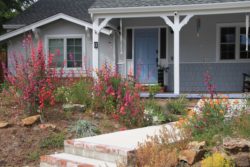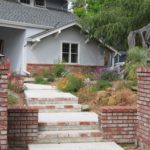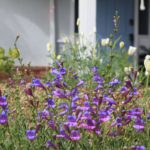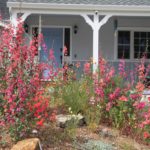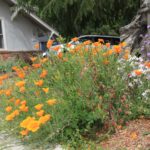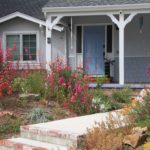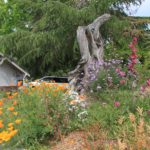Lot size: 2,500 sq. ft. front garden, 90% native
Garden Age: Garden was installed in stages, beginning in 2022
Years on the Bringing Back the Natives Garden Tour: New this year!
Showcase Feature
The large lawn that was in place on the large corner lot when Glenn and David purchased this house in 2021 didn’t last long. Glenn, Executive Director of Golden Gate Audubon, envisioned a garden that would be beautiful, need a minimum of maintenance and little to no water once mature, flourish while being pesticide-free (of course!), and provide food, shelter and nesting areas for birds. Glenn sheet mulched the lawn away, and Glenn and John Bain, of Mariposa Garden Design, designed the garden.
The entrance to the garden is bordered by berms containing succulents such as canyon, fingertip, and chalk dudleyas, several types of sedum, and Lewisia. In spring and summer they are surrounded by an exuberant array of wildflowers, including pink, burgundy, and coral-colored clarkia, yellow and white tidy tips, and orange and cream-colored poppies. New this year are hundreds of native bulbs, including Ithuriel’s spear, blue dicks, and Mariposa lilies.
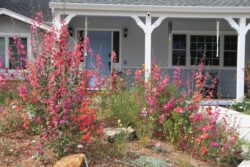 The meadow in front of the living room window—designed to keep the view open—contains the lush-looking and finely-bladed Point Molate red fescue, and graceful alkali sacaton, which has silvery-green leaves and a slightly reddish-to-purplish seed head. The fragrance of the sweetly-scented hummingbird sage drifts through the garden on warm breezes. A large redwood burl and boulders provide visual interest.
The meadow in front of the living room window—designed to keep the view open—contains the lush-looking and finely-bladed Point Molate red fescue, and graceful alkali sacaton, which has silvery-green leaves and a slightly reddish-to-purplish seed head. The fragrance of the sweetly-scented hummingbird sage drifts through the garden on warm breezes. A large redwood burl and boulders provide visual interest.
The garden is bordered by seven types of manzanita (‘Dr. Hurd’, ‘John Dourley’, ‘Sunset’, ‘Shatterberry’, ‘Baby Bear’, ‘Point Arena’, and ‘Monterey Carpet’), which provide stability and interest throughout the year with their beautiful burgundy bark and evergreen leaves. The manzanitas contrast in color, texture, and form with the amazing blue and fragrant flowers of three types of California lilacs (‘Concha’, ‘Yankee Point’, and ‘Joyce Coulter’), and the striking blue-green foliage of the ‘Canyon Prince’ wild rye and ‘Catalina California native fuchsia’. Penstemon and yarrow were planted in order to brighten the garden while the slower-growing shrubs are filling in.
Other Garden Attractions
• Browse the “Plants for Birds” display, which features beautiful, hardy, local native plants that are easy to grow and readily available in nurseries.
• Check out the bird-safe window information, and find out how you can prevent bird / glass collisions at your own home. (Did you know that one billion birds in the U.S. die each year flying into glass—you can prevent this from happening by treating the exteriors of your windows. Find out more here.)
• Take a seat in this peaceful garden and listen to the birds; you won’t want to leave!
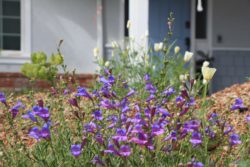 Gardening for Wildlife
Gardening for Wildlife
Interestingly there are no feeders in this garden; as Glenn says, he “Feeds the birds with his plants.” This strategy is clearly successful, as sightings of cedar waxwings, band-tailed pigeons, California towhees, and oat titmice attest. Great horned owls can be heard calling to each other in the evenings. Thrillingly, a California quail was recently seen! The meadow provides shelter for grassland birds, and rock piles were created as homes for lizards.
Green Home Features
This home contains solar panels, a heat pump for heating and cooling the house, and an electric vehicle and charger.
Garden Talks
11:00 and 1:00 “Bringing nature home: how you can create a beautiful garden that will attract birds, butterflies, and bees” by Glenn Phillips
Keystone species (watch this talk by Doug Tallamy!)
Keystone species—our own, local ecological powerhouse plants—in this garden include valley oak, currant, California lilac, manzanita, sage, coyote brush, snowberry, and penstemon.
At least partially wheelchair accessible? Yes


